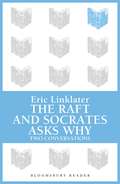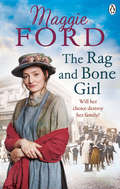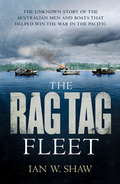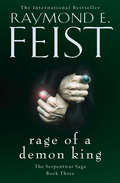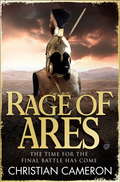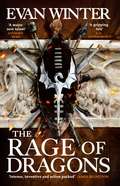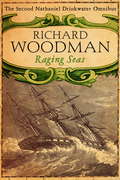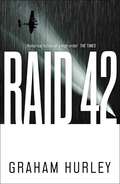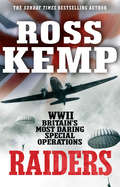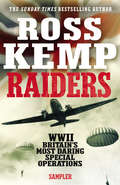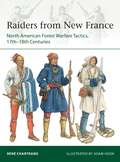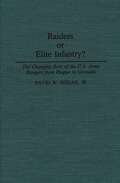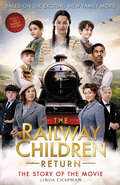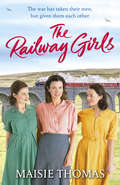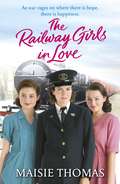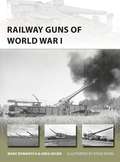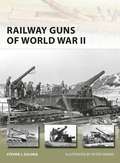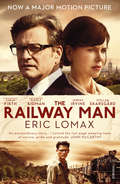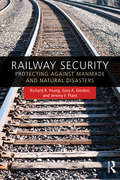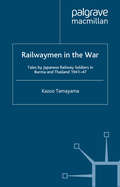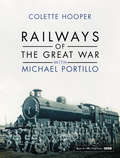- Table View
- List View
The Raft and Socrates Asks Why
by Eric LinklaterAre the people of Britain capable of serving the new world, of writing with honour a new chapter of history? The answer, conclusively, is Yes.… But Socrates, in the third of the pieces, has still to be satisfied that the Allies are truly conscious of their purpose. A four-fold rule of law is not enough: the peace within that rule must not be an idle peace, but creative. If that is not explicitly our intention and desire, then why are we fighting? The Raft and Socrates Asks Why are imaginary conversations revolving around the political and military problems of WWII. The Raft is set in the mid-Atlantic, where six survivors from a torpedoed ship discuss the position of Britain and the difficulties and moral dilemmas of a soldier life. Socrates Asks Why is a conversation between Socrates, Voltaire, Johnson and Lincoln where the Allies' aim of peace and ending of the war is discussed and questioned. These conversations were first published in 1942.
The Rag and Bone Girl
by Maggie FordWhat will she sacrifice for love? Growing up in London’s East End with six siblings, Nora Taylor has always been close to her younger sister Maggie. But when she meets Maggie’s fiancé Robert, they are immediately drawn to each other. Forced to choose between her family and her heart, Nora decides to marry the man she loves – even if it means losing her sister.When the First World War breaks out, Nora must fight to hold her family together through the challenges and tragedies to come. As her children grow up they embark on their own adventures, but another war will threaten all their hopes for the future. Can this broken family survive the dark days of wartime?A sweeping saga charting one family’s fortunes through the First and Second World War and beyond, perfect for fans of Maggie Hope and Dilly Court.
The Rag Tag Fleet: The unknown story of the Australian men and boats that helped win the war in the Pacific
by Ian W. ShawThe unknown story of how a fleet of Australian fishing boats, trawlers and schooners supplied US and Australian forces in the Pacific - and helped turn the course of World War II.Mid-1942: from China to New Guinea, the Pacific belonged to the Japanese. In this desperate situation, a fleet of hundreds of Australian small ships is assembled, sailing under the American flag, and crewed by over 3000 Australians either too young or too old to join the regular armed forces. Their task: to bring supplies and equipment to the Allied troops waging bloody battles against Japanese forces across the South Pacific. THE RAG TAG FLEET is the unknown story of the final months of 1942 - when these men ran the gauntlet of Japanese air attacks, malaria and dysentery, reefs, and shallow, shark-infested waters to support the US and Australian troops that defeated the entrenched Japanese forces at Buna on the New Guinea coast, and so helped turn the war in the Allies' favour. Their bravery, ingenuity and mettle helped turn the tide of the war. For the first time, their story is told.'enthralling . . . makes for a fascinating read.' CANBERRA TIMES
Rage of a Demon King: Book Three Of The Serpentwar Saga (The Serpentwar Saga #3)
by Raymond E. FeistThe third book in the bestselling Serpentwar series.
Rage of Ares (The Long War #6)
by Christian CameronArimnestos of Plataea was one of the heroes of the Battle of Marathon, in which the heroic Greeks halted the invading Persians in their tracks, and fought in the equally celebrated naval battle at Salamis.But even these stunning victories only served to buy the Greeks time, as the Persians gathered a new army, returning with overwhelming force to strike the final killing blow.For the Greeks, divided and outnumbered, there was only one possible strategy: attack. And so, in the blazing summer of 479 BC, Arimnestos took up his spear one final time at the Battle of Plataea.
The Rage of Dragons: Book one of the Burning (The Burning #1)
by Evan Winter'A captivating epic fantasy from a major new talent' Anthony Ryan, author of Blood Song'Intense, inventive and action-packed from beginning to end - a relentlessly gripping, brilliant read' James Islington, author of The Shadow of What Was LostThe Omehi people have been fighting an unwinnable war for generations. The lucky ones are born gifted: some have the power to call down dragons, others can be magically transformed into bigger, stronger, faster killing machines. Everyone else is fodder, destined to fight and die in the endless war. Tau Tafari wants more than this, but his plans of escape are destroyed when those closest to him are brutally murdered.With too few gifted left the Omehi are facing genocide, but Tau cares only for revenge. Following an unthinkable path, he will strive to become the greatest swordsman to ever live, willing to die a hundred thousand times for the chance to kill three of his own people.THE RAGE OF DRAGONS LAUNCHES AN UNMISSABLE EPIC FANTASY SERIES ABOUT A WORLD CAUGHT IN AN ENDLESS WAR AND THE YOUNG MAN WHO WILL BECOME HIS PEOPLE'S ONLY HOPE FOR SURVIVAL'Utter and complete perfection. Winter has created an absolute masterpiece of a novel' The Bookbag'Intense, vivid and brilliantly realized - a necessary read' Anna Smith Spark, author of The Court of Broken Knives'Stunning debut fantasy' Publishers Weekly'Fans of Anthony Ryan's Blood Song will love this' Django Wexler, author of The Thousand Names'A Xhosa-inspired world complete with magic, dragons, demons and curses, The Rage of Dragons takes classic fantasy and imbues it with a fresh and exciting twist' Anna Stephens, author of Godblind'A gripping tale . . . with one of the most enthralling hero's journeys I've read' S. A. Chakraborty, author of City of Brass
Raging Seas: The Bomb Vessel, The Corvette, 1805 (Nathaniel Drinkwater Omnibus #6)
by Richard WoodmanTHE BOMB VESSEL It is 1801, and Napoleon is reaching supreme power in France and has allied himself with Tsar Paul of Russia. Drinkwater is in command of an old bomb ship, the Virago, which joins battle off the Danish coast. Amid gales and ice, Drinkwater strives to save his ship and his brother. THE CORVETTE The frozen splendour of the Arctic Ocean and the absorbing drama of a nineteenth-century whale hunt unfold in The Corvette, in which Drinkwater finds himself battling with the enemy, the elements and fiercely independent whalemasters in a three-handed struggle for mastery of icy Arctic waters. 1805 Drinkwater is sent to patrol the Channel coast, helping the Royal Navy maintain a heroic blockade of the enemy's post, but soon his ship the Antigone is needed elsewhere as everything now hinges on the confrontation that Nelson has forced off Cape Trafalgar.
Raid 42 (Spoils of War #4)
by Graham Hurley'Historical fiction of a high order' The Times Spring, 1941. The war in the West is as good as won. Nation after nation has fallen before the Reich's armies. Only Britain endures, her cities under nightly bombardment from the Luftwaffe.Berlin would happily call off the bombers in exchange for a peace treaty. Hitler would like to persuade Britain to turn her back on Europe, to attend to her precious Empire instead, to allow Germany a free hand to deal with the real enemy in the East.Peace, perhaps, but at what cost?For Churchill the price is too high; but for others within the British establishment, it is a price worth paying. On both sides of the channel, advocates of total war or peace-at-all-costs are at each others' throats – all unaware that Rudolf Hess, Hitler's quiet, contemplative deputy, has already taken radical steps to change the fortunes of the war...Raid 42 is part of the SPOILS OF WAR Collection, a thrilling, beguiling blend of fact and fiction born of some of the most tragic, suspenseful, and action-packed events of World War II. From the mind of highly acclaimed thriller author GRAHAM HURLEY, this blockbuster non-chronological collection allows the reader to explore Hurley's masterful storytelling in any order, with compelling recurring characters whose fragmented lives mirror the war that shattered the globe.
Raiders: World War Two True Stories
by Ross KempTo the people of Great BritainWorld War II was the deadliest and bloodiest war in history. Never before or since have so many people made such a personal sacrifice in the line of duty.Raiders tells the extraordinary true stories of six of the most daring special operations ever undertaken in warfare and the heroism of the people behind them.Operation Chariot was the most ambitious amphibious raid ever mounted by the British Forces. Attacking the heavily fortified dry dock at St Nazaire in German occupied France, an elite group of commandos battered their way through a maelstrom of bullets and incendiaries. Their boat is punctured by over a hundred shell holes, the dead and wounded lie all around them on the decks, but still their guns are blazing and still they press on...'Courage is the first of human qualities because it is the quality that guarantees all others'Winston Churchill
Raiders (eBook Sampler): Wwii Britain's Most Daring Special Operations
by Ross KempA free sampler of Ross Kemp's Raiders: six true stories of the most daring British operations of World War Two.This sampler contains the story of Operation Judgement; believed to be one of the most incredible raids of World War Two.The full ebook and hardback will be available on 25th October 2012.Six raids that changed the course of history.Operation Judgement: one of the most spectacular efforts of World War Two, where obsolete British biplanes attacked the Italian fleet in Taranto.Operation Archery: the first true combined operation carried out by all three British forces. THis successful raid persuaded Hitler that the Allies were planning a full scale invasion.Operation Biting: a cross-Channel raid into France that was the first major attack by the British Airborne Division and its first battle honour.Operation Gunnerside: a dramatic demolition assault on Hitler's atomic bomb plant in Norway.Operation Chariot: 'the greatest raid of all': the British amphibious attack on the Normandie dry dock at St Nazaire in German-occupied France.Operation Deadstick: the story of the first Allies into the fray on D-Day, tasked with seizing and holding two bridges to prevent an armoured German counter-attack.
Raiders from New France: North American Forest Warfare Tactics, 17th–18th Centuries (Elite)
by René ChartrandThough the French and British colonies in North America began on a 'level playing field', French political conservatism and limited investment allowed the British colonies to forge ahead, pushing into territories that the French had explored deeply but failed to exploit. The subsequent survival of 'New France' can largely be attributed to an intelligent doctrine of raiding warfare developed by imaginative French officers through close contact with Indian tribes and Canadian settlers. The ground-breaking new research explored in this study indicates that, far from the ad hoc opportunism these raids seemed to represent, they were in fact the result of a deliberate plan to overcome numerical weakness by exploiting the potential of mixed parties of French soldiers, Canadian backwoodsmen and allied Indian warriors.Supported by contemporary accounts from period documents and newly explored historical records, this study explores the 'hit-and-run' raids which kept New Englanders tied to a defensive position and ensured the continued existence of the French colonies until their eventual cession in 1763.
Raiders from New France: North American Forest Warfare Tactics, 17th–18th Centuries (Elite #229)
by René ChartrandThough the French and British colonies in North America began on a 'level playing field', French political conservatism and limited investment allowed the British colonies to forge ahead, pushing into territories that the French had explored deeply but failed to exploit. The subsequent survival of 'New France' can largely be attributed to an intelligent doctrine of raiding warfare developed by imaginative French officers through close contact with Indian tribes and Canadian settlers. The ground-breaking new research explored in this study indicates that, far from the ad hoc opportunism these raids seemed to represent, they were in fact the result of a deliberate plan to overcome numerical weakness by exploiting the potential of mixed parties of French soldiers, Canadian backwoodsmen and allied Indian warriors.Supported by contemporary accounts from period documents and newly explored historical records, this study explores the 'hit-and-run' raids which kept New Englanders tied to a defensive position and ensured the continued existence of the French colonies until their eventual cession in 1763.
Raiders or Elite Infantry?: The Changing Role of the U.S. Army Rangers from Dieppe to Grenada (Contributions in Military Studies)
by David W. HoganHow have the U.S. Army Rangers acted as special operations forces in military operations since 1942? Hogan's study examines the nature and purpose of the Rangers over the past fifty years and shows how they have served as scouts, raiders, assault troops, and elite infantry. They have spearheaded amphibious landings, raided enemy prison camps, patrolled behind enemy lines in Korea, served alongside Green Berets in Vietnam, and carried out special missions in Grenada. Professional officers, military historians, students, and general readers will find this a fascinating history.This analytical account opens with a short description of the origins of the Ranger legend in America and then moves to a discussion of their use in World War II, as commandos in 1942, then as spearheaders in 1943 and 1944, as line infantry in Europe and as special operations forces in the Pacific. This provocative assessment also traces the development of Ranger raider units in Korea, the special training and use of Green Berets as Rangers in Vietnam, and the shifting of Ranger roles into more complex and varied types of operations in Vietnam and Grenada and in a world of increasing terrorism and changing combat situations. Illustrations, maps, and a lengthy bibliography add to the usefulness of the study.
The Railway Children Return
by Linda ChapmanA heartwarming novelisation of the sequel to one of the most beloved British family films of all time, The Railway Children. The Railway Children Return, out in cinemas April 2022, imagines ES Nesbit’s treasured story fifty years on, bringing an enchanting new adventure to a new generation of fans.
The Railway Girls
by Maisie Thomas__________________________________The first novel in the wonderful new Railway Girls series, perfect for fans of Nancy Revell and Ellie Dean.In February, 1922, at the western-most entrance to Victoria Station in Manchester, a massive plaque was unveiled. Beneath a vast tiled map showing the lines of the Lancashire and Yorkshire Railway network, a series of seven bronze panels recorded the names of the men of the Lancashire and Yorkshire Railway who gave their lives for King and Country in the Great War – a total of 1,460 names.In March, 1940, a group of women of varying ages and backgrounds, stand in front of the memorial, ready to do their bit in this new World War..._________________________________________Mabel is determined to make a fresh start as a railway girl where no one will know the terrible thing she did and she can put her guilt behind her... Or is she just running away?Meanwhile Joan will never be as good as her sister, or so her Gran keeps telling her. A new job as a station clerk could be just the thing she needs to forget her troubles at home.And Dot is further into her forties than she cares to admit. Her beloved sons are away fighting and her husband – well, the less said about him the better. Ratty old sod. She is anxious to become a railway girl just like her dear mam – anything to feel she is supporting the sons she prays for every night.The three women start off as strangers, but soon form an unbreakable bond that will get them through the toughest of times...
The Railway Girls in Love (The railway girls series #3)
by Maisie ThomasThe brand new Railway Girls novel set in Manchester during WWII. Perfect for fans of Nancy Revell, Daisy Styles and Margaret Dickinson.___________________Readers LOVE the Railway Girls: 'Gripping and intriguing''Great story lines''Exceptional story . . . a must-read' 'Poignant''Emotional . . . strong women' ___________________Love is in the air, and together the railway girls can overcome even the hardest of times.Mabel has finally put the past behind her, and her relationship with the dashing Harry is stronger than ever. That is, until an old flame shows up, leaving Mabel questioning her future.Meanwhile Joan has made amends with Bob - if only she could do the same with Gran. And there's still that family mystery she wants answer to, isn't there?As a mother and grandmother, Dot Green has always put her family first. Her job as a parcels porter has brought new purpose to her life, so is it finally time to start following her heart . . .Life as a railway girl is busy but as war rages on and air raids disrupt daily life, the women realise they need each other more than ever, especially when there might be wedding bells on the horizon.
Railway Guns of World War I (New Vanguard #249)
by Steve Noon Marc Romanych Greg HeuerWorld War I was the Golden Age of the railway gun. Even though at the start of the conflict none of the armies possessed any railway artillery pieces and the very idea was comparatively new, more railway guns were used during this war than in any other conflict. Designed to break the stalemate of trench warfare, the first railway guns were simple, improvised designs made by mounting surplus coastal defence, fortress, and naval guns onto existing commercial railway carriages. As the war dragged on, railway artillery development shifted to longer range guns that could shell targets deep behind enemy lines. This change of role brought much larger and more sophisticated guns often manufactured by mounting long-barrel naval guns to specially-designed railway carriages.This book details the design and development of railway guns during World War I from the very first basic designs to massive purpose built "monster" railway guns. Accompanying the text are many rare, never-before-published, photographs and colour illustrations depicting how these weapons were used during World War I.
Railway Guns of World War I (New Vanguard #249)
by Steve Noon Marc Romanych Greg HeuerWorld War I was the Golden Age of the railway gun. Even though at the start of the conflict none of the armies possessed any railway artillery pieces and the very idea was comparatively new, more railway guns were used during this war than in any other conflict. Designed to break the stalemate of trench warfare, the first railway guns were simple, improvised designs made by mounting surplus coastal defence, fortress, and naval guns onto existing commercial railway carriages. As the war dragged on, railway artillery development shifted to longer range guns that could shell targets deep behind enemy lines. This change of role brought much larger and more sophisticated guns often manufactured by mounting long-barrel naval guns to specially-designed railway carriages.This book details the design and development of railway guns during World War I from the very first basic designs to massive purpose built "monster" railway guns. Accompanying the text are many rare, never-before-published, photographs and colour illustrations depicting how these weapons were used during World War I.
Railway Guns of World War II (New Vanguard)
by Peter Dennis Steven J. ZalogaWorld War II marked the zenith of railway gun development. Although many of the railway guns deployed at the start of the conflict were of World War I vintage, Germany's ambitious development programme saw the introduction of a number of new classes, including the world's largest, the 80cm-calibre Schwerer Gustav and Schwerer Dora guns, which weighed in at 1,350 tons and fired a huge 7-ton shell.This book provides an overview of the types of railway guns in service during World War II, with a special focus on the German railway artillery used in France, Italy and on the Eastern Front, and analyzes why railway guns largely disappeared from use following the end of the war.
Railway Guns of World War II (New Vanguard #231)
by Peter Dennis Steven J. ZalogaWorld War II marked the zenith of railway gun development. Although many of the railway guns deployed at the start of the conflict were of World War I vintage, Germany's ambitious development programme saw the introduction of a number of new classes, including the world's largest, the 80cm-calibre Schwerer Gustav and Schwerer Dora guns, which weighed in at 1,350 tons and fired a huge 7-ton shell.This book provides an overview of the types of railway guns in service during World War II, with a special focus on the German railway artillery used in France, Italy and on the Eastern Front, and analyzes why railway guns largely disappeared from use following the end of the war.
The Railway Man: A True Story Of War, Remembrance And Forgiveness (Movie Tie-in Editions Ser. #0)
by Eric LomaxDuring the Second World War Eric Lomax was forced to work on the notorious Burma-Siam Railway and was tortured by the Japanese for making a crude radio.Left emotionally scarred and unable to form normal relationships, Lomax suffered for years until, with the help of his wife, Patti Lomax, and of the Medical Foundation for the Care of Victims of Torture, he came terms with what happened. Fifty years after the terrible events, he was able to meet one of his tormentors. The Railway Man is a story of innocence betrayed, and of survival and courage in the face of horror.
Railway Security: Protecting Against Manmade and Natural Disasters
by Richard R. Young Gary A. Gordon Jeremy F. PlantThis book provides an overview and assessment of the security risks, both manmade and natural, facing the railways and rail networks.Railroads face significant threats from disasters, but with situational awareness and coordinated effort these can often be substantially minimized. Transportation assets have always been vulnerable to natural disasters, but in the current environment these assets are also a preferred target of human-caused disruption, especially in the form of terrorism, as the events in many other parts of the world have underscored. Railways are not a homogeneous mode of transportation given their various roles in intercity and commuter passenger movement, as well as being a major portion of the freight ton-miles upon which the U.S. economy is highly dependent. Designed to provide advice for railway owners and first responders, this text discusses how to secure hazardous material transport and how to establish guidelines for rail freight operations and rail passenger operations. The book aims to develop an understanding of the unique operating characteristics of railways, the nature and the range of vulnerabilities, the present means for protecting the infrastructure, and the public policy initiatives that are prerequisite for developing a comprehensive appreciation of the magnitude of this issue. The book utilizes case studies of transport disasters to illustrate lessons learned and to provide critical insight into preventative measures.This book will be of great interest to students and practitioners of transportation, technology and engineering, and security management.
Railway Security: Protecting Against Manmade and Natural Disasters
by Richard R. Young Gary A. Gordon Jeremy F. PlantThis book provides an overview and assessment of the security risks, both manmade and natural, facing the railways and rail networks.Railroads face significant threats from disasters, but with situational awareness and coordinated effort these can often be substantially minimized. Transportation assets have always been vulnerable to natural disasters, but in the current environment these assets are also a preferred target of human-caused disruption, especially in the form of terrorism, as the events in many other parts of the world have underscored. Railways are not a homogeneous mode of transportation given their various roles in intercity and commuter passenger movement, as well as being a major portion of the freight ton-miles upon which the U.S. economy is highly dependent. Designed to provide advice for railway owners and first responders, this text discusses how to secure hazardous material transport and how to establish guidelines for rail freight operations and rail passenger operations. The book aims to develop an understanding of the unique operating characteristics of railways, the nature and the range of vulnerabilities, the present means for protecting the infrastructure, and the public policy initiatives that are prerequisite for developing a comprehensive appreciation of the magnitude of this issue. The book utilizes case studies of transport disasters to illustrate lessons learned and to provide critical insight into preventative measures.This book will be of great interest to students and practitioners of transportation, technology and engineering, and security management.
Railwaymen in the War: Tales by Japanese Railway Soldiers in Burma and Thailand 1941-47
by K. TamayamaThe Japanese railway soldiers, who built the notorious Burma-Thailand railway in 1942-43, earned an unenviable reputation for brutality, but they have not hitherto told their own story. This is the first book to bring to light the testimonies of the soldiers of the Emperor, who worked with 55,200 British, Australian and Dutch prisoners of war in the construction of the 415 kilometre railway.
Railways of the Great War with Michael Portillo
by Colette HooperFrom the exploits of railwaymen at the Front to the secrets of railway spies who worked behind enemy lines; the manufacture of munitions in railway workshops to the role of railways in post-war remembrance – this book explores some of the remarkable stories of the railway war. Individually, each illuminates a different aspect of the conflict. Taken together, they provide us with a fresh perspective on the First World War as a whole.The Great War was the quintessential railway war. Railways helped to precipitate this mechanized conflict: they defined how it was fought and kept the home front moving; they conveyed millions to the trenches and evacuated the huge numbers of wounded. The railways sustained a terrible war of attrition and, ultimately, bore witness to its end.In Railways of the Great War, Michael Portillo and Colette Hooper tell the forgotten story of the war on the tracks and explore the numerous ways in which Britain’s locomotives, railway companies and skilled railway workforce moulded the course of the conflict. From mobilizing men and moving weapons, to transporting food for troops and later taking grieving relatives to the battlefields on which their loved ones had fallen, the railways played a central role throughout this turbulent period in our history.
